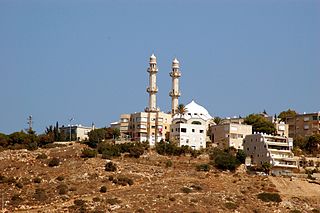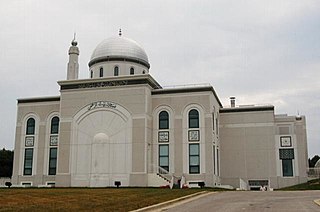
Kababir is a mixed neighbourhood with a majority of Ahmadi Muslim Arabs and a significant minority of Jews in Haifa, Israel.

Guatemala is a predominantly Christian country, with Islam being a small minority religion. Due to secular nature of the Guatemala's constitution, Muslims are free to proselytize and build places of worship in the country.

The Ahmadiyya branch of Islam has been subjected to various forms of religious persecution and discrimination since the movement's inception in 1889. The Ahmadiyya Muslim movement emerged within the Sunni tradition of Islam and its adherents believe in all of the five pillars and all of the articles of faith required of Muslims. Ahmadis are considered non-Muslims by many mainstream Muslims since they consider Mirza Ghulam Ahmad, the founder of the movement, to be the promised Mahdi and Messiah awaited by the Muslims.

Ahmadiyya is an Islamic branch in Switzerland, under the spiritual leadership of the caliph in London. The Community was founded on October 13, 1946, during the late period of the Second Caliphate, when the caliph directed Shaikh Nasir Ahmad to establish a mission in the country. Today there are two Ahmadi mosques and 14 local branches, representing an estimated 800 Ahmadi Muslims.

Islam is a minority religion in the island nation Tuvalu. With the introduction of Ahmadiyya Islam in 1985 by Ahmadi Muslims, there are approximately 50 Ahmadi Muslims in the country, of which all are members of the Ahmadiyya movement. Due to the country's small population of 10,679, this represents 0.46% of Tuvalu. The Tuvalu Mosque, in Funafuti, the capital of Tuvalu, is the only mosque in the country.

The Al Mahdi Mosque is an Ahmadi Muslim mosque in Bradford, England. The mosque was built at a cost £2.5 million entirely from voluntary donations of British Ahmadi Muslims. The mosque was opened on 7 November 2008 by Mirza Masroor Ahmad, the current and fifth caliph of Ahmadiyya Muslim Community. With a capacity of 2,000 worshippers, it is among the largest in the city. The inauguration was attended by many Ahmadi Muslims and over 300 guests. The mosque, on Rees Way, was built at the top of a hill and is visible from miles around within the city.

Baitur Rehman Mosque is located in Silver Spring, Maryland in the United States. The mosque was inaugurated by Mirza Tahir Ahmad, the late head of the Ahmadiyya Muslim Community, on October 14, 1994. The mosque is run by the Ahmadiyya Muslim Community. An estimated 5,000 Ahmadis and guests from across the United States attended the opening ceremony.

Ahmadiyya, officially the Ahmadiyya Muslim Community or the Ahmadiyya Muslim Jama'at, is an Islamic revival or messianic movement originating in Punjab, British India, in the late 19th century. It was founded by Mirza Ghulam Ahmad (1835–1908), who claimed to have been divinely appointed as both the Promised Mahdi and Messiah expected by Muslims to appear towards the end times and bring about, by peaceful means, the final triumph of Islam; as well as to embody, in this capacity, the expected eschatological figure of other major religious traditions. Adherents of the Ahmadiyya—a term adopted expressly in reference to Muhammad's alternative name Aḥmad—are known as Ahmadi Muslims or simply Ahmadis.

The May 2010 Lahore attacks, also referred to as the Lahore massacre, occurred on 28 May 2010, in Lahore, Punjab, Pakistan, during Friday prayers. 94 people were killed and more than 120 others were injured in nearly simultaneous attacks against two mosques of the minority Ahmadiyya muslim community. After the initial attack, a hostage situation lasted for hours. Tehrik-i-Taliban Pakistan, as well as their Punjab wing, claimed responsibility for the attacks and were also blamed by the Pakistani Police.

The Ahmadiyya Community Bangladesh or Ahmadiyya Jama'at Bangladesh is the branch of the worldwide Ahmadiyya Muslim Community in Bangladesh. There are an estimated 100,000 Ahmadis in the country as of 2004.

Ahmadiyya in Israel is a small Muslim community in Israel. The Community was first established in the region in the 1920s, in what was then the British Mandate of Palestine. Israel is the only country in the Middle East where the Ahmadi branch of Islam can be openly practiced. As such, Kababir, a neighbourhood on Mount Carmel in Haifa, Israel, acts as the Middle East headquarters of the Community. It is unknown how many Israeli Ahmadis there are, although it is estimated there are about 2,200 Ahmadis in Kababir alone.

The Ahmadiyya Muslim Community was established in United Kingdom with the pioneering efforts of Chaudhry Fateh Muhammad Sial, who arrived in London in July in 1913. Sial was the first missionary sent overseas by the Ahmadiyya Muslim Community and was under the direction of Hakeem Noor-ud-Din, the first caliph of the movement.

Islam is a minority religion in the Marshall Islands. All Muslims in the country belong to the minority Ahmadiyya sect. The Ahmadiyya mosque in Uliga, first constructed in 2012 in the Marshall Islands is the only mosque in Oceania's subregion of Micronesia. According to a 2009 report there were about 10 Muslims in the Marshall Islands, although more recent reports indicate about 150 believers in the country.

Ahmadiyya is an Islamic branch in Spain, under the spiritual leadership of the caliph in London. The earliest history of the Community in Spain dates back to the period of the Second Caliph, when Malik Mohammad Sharid Gujrati, a missionary of the Community, arrived in Madrid on March 10, 1936. However, in the same year the Spanish Civil War broke out forcing Gujrati to abandon the country. Missionary efforts commenced once again following the Second World War, in 1946 when Karam Ilahi Zafar was sent by the caliph. The Basharat Mosque in Pedro Abad, built by the Ahmadiyya in the 1980s is the first mosque to be built in Spain since the Fall of Granada and the end of Muslim rule at the end of the 15th century. Today there are two purpose-built Ahmadi Muslim mosques and roughly 500 adherents in Spain.

Ahmadiyya is a religious community in Norway, under the spiritual leadership of the caliph in London. In the history of the Community it is stated that two Norwegian women converted in the 1920s. However, it was not until 1957, during the era of the Second Caliphate, when Kamal Yousuf, then a missionary in Sweden, moved to Oslo to establish the first Ahmadiyya mission in the country. Today, there are a number of mosques, including the largest mosque in Scandinavia, the Baitun Nasr Mosque, representing an estimated 1700 Ahmadi in the country.

Ahmadiyya is an Islamic community in Guinea-Bissau, under the leadership of the caliph in London. First established in the country in 1995, during the era of the Fourth Caliphate, the Community represents an estimated 2% of the country's Muslim population, corresponding to approximately 13,000 people.

Ahmadiyya is a community in Ireland under the spiritual leadership of the caliph in London. The Community was formally registered in the country in 1992, during the era of the Fourth Caliphate. Today there are two Ahmadiyya mosques in the country, one of which is purpose-built, representing up to 500 Ahmadis in the country.

Ahmadiyya is an Islamic movement in Australia, first formally founded in the country in the 1980s, during the era of the fourth caliph. However, the history of the Community dates back to the early 20th century, during the lifetime of the founder of the movement, Mirza Ghulam Ahmad, with the first contacts arising as a consequence of Australians travelling to British India, and also as a consequence of early, "Afghan" camel drivers settling in Australia during the mid to late 19th century. Today there are at least four Ahmadi mosques in four of the six Australian states, representing an estimated 6,000-8,000 Australian Ahmadis in the country.

The Aqsa Mosque or Masjid Aqsa is an Ahmadi mosque in Qadian, India. The mosque was built by Mirza Ghulam Murtaza, father of Mirza Ghulam Ahmad, the founder of the Ahmadiyya movement, in 1876. The mosque had been renovated and extended repeatedly throughout the 20th century by the Ahmadiyya administration and the capacity of the building increased from its initial capacity of 200 to 15,000 by the year 2014. The mosque is situated inside the compound of the family house of Ghulam Ahmad which now serves as the centre of the Ahmadiyya Muslim Community in India located close to the White Minaret and important offices of the community. The mosque is also a venue for various religious meetings and events.









